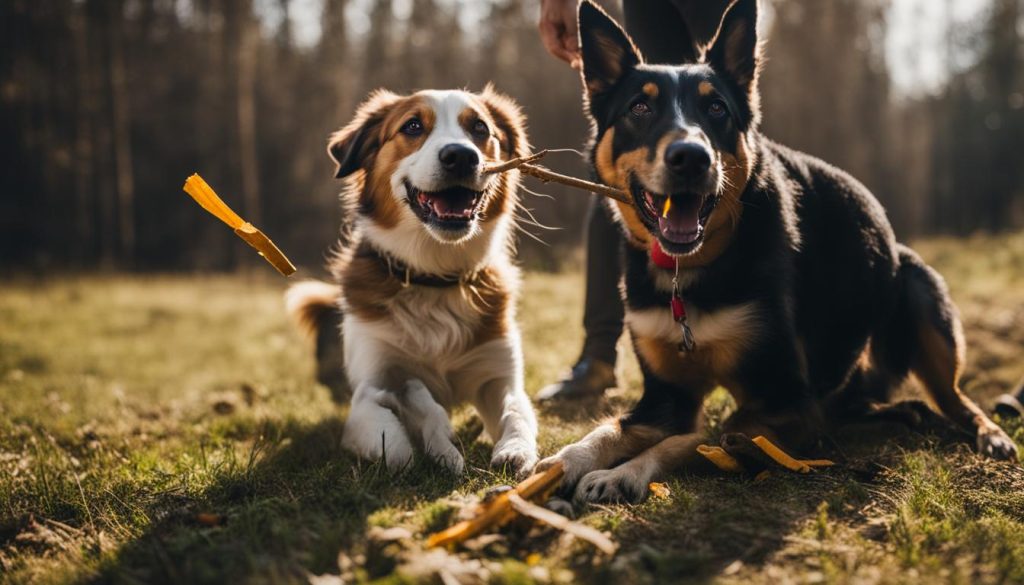As a professional journalist, I have always been fascinated by the peculiar habits of our beloved furry friends. One question that often comes to mind is why dogs have such an affinity for sticks. Whether it’s during a leisurely walk in the park or a spirited game of fetch, we can’t help but wonder what drives this behavior.
When it comes to canine behavior, there are several reasons behind dogs’ love for sticks. One of the primary factors is their natural instinct to fetch and carry objects. Dogs have an innate desire to explore the world using their mouths, and sticks provide an interesting and interactive plaything. The unique smell and texture of sticks also pique their curiosity, making them all the more enticing. Additionally, the challenge of carrying a large stick can be a source of motivation for dogs, as they seek to prove their strength and impress their owners.
However, it’s important to remember that chewing on sticks can pose potential risks to our furry companions. Splintering of sticks can lead to choking hazards or intestinal blockages, while chewing can cause oral pain and infection. Playing fetch with sticks can even result in serious injuries, including stick impalement in the mouth or throat.
Therefore, it’s crucial for pet owners to provide safer alternatives for their dogs to chew on. By redirecting their behavior towards appropriate chew toys, we can help satisfy their natural inclination to chew while minimizing the associated risks. Consistent training and reinforcement, along with engaging in regular mental and physical exercise, can further deter dogs from chewing sticks out of boredom or anxiety.
Key Takeaways:
- Dogs are naturally inclined to fetch and carry objects, such as sticks, due to their instinctual behavior.
- The unique smell and texture of sticks make them appealing to dogs, stimulating their curiosity.
- Chewing on sticks can pose potential risks, including splintering, choking hazards, and oral injuries.
- Providing safer alternatives, consistent training, and regular exercise can help redirect dogs’ chewing behavior.
- It’s important to prioritize the safety and well-being of our furry friends by understanding their behavior and promoting responsible play.
The Instinctual Hunt/Prey Drive Behind Dogs’ Stick Obsession

Dogs’ love for sticks can be attributed to their instinctual hunt and prey drive. This innate behavior stems from their ancestors’ need to search, stalk, and capture prey for survival. When dogs chase, grab, and bite sticks, it mirrors their ancestral instinct to capture and bring back food to the pack.
The act of carrying sticks can be seen as a way for dogs to fulfill their role as hunters and providers. By bringing back sticks to their den or pack, dogs may be signaling their successful hunt and contributing to the collective well-being of their group. This behavior is deeply rooted in their genetic makeup and serves as a source of fulfillment and accomplishment.
It is important to note that while dogs’ stick obsession can be traced back to their prey drive, it’s essential to ensure their safety. Chewing on sticks can lead to potential hazards such as splintering, choking, and gastrointestinal obstructions. As responsible pet owners, it is our duty to provide safer alternatives for our dogs to satisfy their natural instincts and prevent any potential harm.
The Hunt/Prey Drive in Action
“When my dog grabs a stick and runs with it, I can see the primal instincts kicking in. It’s fascinating to watch as he channels his inner hunter and brings the stick back to the pack. However, I always make sure to provide him with appropriate toys and chews to keep him safe and satisfied.”
Dogs’ stick obsession is a complex behavior driven by their instinctual hunt and prey drive. Understanding this innate drive can help us promote safer alternatives and ensure the well-being of our furry friends.
Other Reasons Dogs Like Sticks
While the instinctual hunt and prey drive explain the primary motivation behind dogs’ stick obsession, there are other reasons why dogs are attracted to sticks. Sticks can serve as nature’s toys, offering dogs a source of entertainment and play. Some dogs may also see sticks as resembling bones, which are highly valued by canines. Furthermore, sticks have different smells and tastes that excite their sensory receptors. For teething puppies, chewing on sticks can alleviate the discomfort of sore gums. However, indiscriminate eating of sticks could be a sign of pica, a behavioral condition that may indicate nutritional deficiencies or other underlying issues. Dogs may also carry sticks or seek attention from their owners through this behavior, and chewing on sticks can help reduce anxiety in certain dogs.
The Allure of Sticks as Nature’s Toys
Sticks are simple and readily available objects found in nature, making them an appealing toy for dogs. The natural shape and texture of sticks provide dogs with an interactive and engaging play experience. Whether they are chasing, pouncing on, or even fetching sticks, dogs enjoy the physical activity and mental stimulation that comes with playing with these natural toys.
The Resemblance to Bones
Dogs have an innate instinct to chew on bones as a way to satisfy their natural urge to gnaw and keep their teeth clean. Sticks, with their similar shape and hardness, can resemble bones to dogs. Chewing on sticks provides dogs with the sensation and satisfaction they would get from gnawing on a bone, helping to alleviate boredom and provide dental benefits.
The Sensory Experience of Sticks
“The smell and taste of different sticks can be highly stimulating for dogs. Each stick carries its own unique scent, which can be intriguing for dogs who rely heavily on their sense of smell.”
Dogs have a remarkable sense of smell, and the various smells and tastes of different sticks can be highly stimulating for them. Each stick carries its own unique scent, which can be intriguing for dogs who rely heavily on their sense of smell to explore and understand the world around them. This sensory experience adds to the allure of sticks and makes them even more enticing to dogs.
Chewing for Teething Puppies and Anxiety Reduction
“Chewing on sticks can alleviate the discomfort of sore gums for teething puppies, providing them with a natural way to relieve the pain and pressure.”
For teething puppies, chewing on sticks can alleviate the discomfort of sore gums. The act of chewing helps to relieve the pain and pressure caused by emerging teeth. Additionally, chewing on sticks can serve as a stress-reliever for dogs, helping them to reduce anxiety and provide a sense of comfort and security.
| Reasons Why Dogs Like Sticks | Description |
|---|---|
| Sticks as nature’s toys | Sticks provide dogs with a source of entertainment and play, offering an interactive and engaging play experience. |
| Resemblance to bones | Sticks can resemble bones to dogs, satisfying their natural urge to gnaw and helping to keep their teeth clean. |
| Sensory experience | The different smells and tastes of sticks stimulate dogs’ senses, adding to their fascination and appeal. |
| Alleviate sore gums | Chewing on sticks can provide relief for teething puppies with sore gums, easing discomfort and pressure. |
| Anxiety reduction | Chewing on sticks can help reduce anxiety in certain dogs, providing comfort and a sense of security. |
Safety Considerations: Potential Risks and Hazards of Chewing Sticks
When it comes to dogs chewing sticks, there are several safety considerations that pet owners need to be aware of. While it may seem like a harmless behavior, there are potential risks and hazards that can arise.
One of the main concerns is the splintering of sticks. As dogs chew on sticks, they can break off small pieces, which can pose a choking hazard or lead to obstructions in the gastrointestinal tract. These obstructions can be painful and may require surgical intervention to remove.
Chewing sticks can also result in oral pain and infection. The act of chewing on rough sticks can cause cuts and abrasions in a dog’s mouth, making them susceptible to bacteria and infection. Additionally, small splinters can become lodged between teeth, causing discomfort and potential dental issues.
Ingestion of sticks can lead to serious injuries, such as stick impalement in dogs. When dogs chase and catch sticks in their mouth, there is a risk of the stick becoming lodged in their throat or penetrating their mouth, causing severe injuries and potential damage to vital organs.
Playing fetch with sticks can be particularly hazardous, posing a risk of stick impalement or injury if a dog fails to catch the stick correctly or if it is thrown with excessive force. It is important for pet owners to consider safer alternatives for play, such as using dog-safe toys or balls specifically designed for fetch activities.
| Potential Risks and Hazards of Chewing Sticks: | Precautions: |
|---|---|
| Splintering of sticks | Avoid giving dogs access to sticks or closely supervise their play to prevent ingestion of small splinters |
| GI tract obstruction | Provide dogs with safe chew toys and discourage them from chewing on sticks |
| Oral pain and infection | Regularly inspect your dog’s mouth for any signs of oral injury or infection, and seek veterinary care if needed |
| Stick impalement in dogs | Avoid playing fetch with sticks and opt for safer alternatives, such as dog-safe toys or balls |
How to Stop Your Dog from Chewing Sticks

If you want to prevent your dog from chewing sticks, there are several effective strategies you can employ. One of the most important steps is redirecting their behavior by providing them with safe chew toys specifically designed for dogs. These toys can help satisfy their natural urge to chew and keep them engaged in a positive and constructive activity. It’s essential to choose chew toys that are durable, non-toxic, and appropriate for your dog’s size and breed.
Consistent training and reinforcement are also key in teaching dogs to leave sticks alone. When you catch your dog attempting to chew a stick, firmly say “no” or use a similar command to redirect their attention to a chew toy. Reward them with treats or praise when they choose the toy instead of the stick. Positive reinforcement techniques help strengthen the association between the desired behavior and the reward, making it more likely for your dog to repeat the desired behavior.
In addition to redirecting behavior, engaging your dog in regular mental and physical exercise can help reduce their desire to chew on sticks out of boredom. Dogs need both mental stimulation and physical activity to stay happy and content. Consider incorporating interactive toys, puzzle games, and regular walks or play sessions to keep them mentally and physically stimulated. A tired dog is less likely to engage in destructive chewing behaviors.
Regular veterinary check-ups are also crucial in preventing and addressing potential underlying issues that may contribute to your dog’s chewing behavior. Your veterinarian can assess your dog’s overall health, identify any dental problems that may cause discomfort, and provide guidance on behavior modification techniques. They may also recommend dental chews or other dental care products that can satisfy your dog’s chewing needs while promoting oral health.
Summary:
- Provide your dog with safe chew toys to redirect their chewing behavior away from sticks.
- Consistently train and reinforce the desired behavior using positive reinforcement techniques.
- Engage your dog in regular mental and physical exercise to reduce boredom and the urge to chew on sticks.
- Schedule regular veterinary check-ups to address potential underlying health issues and receive guidance on behavior modification.
Wrapping Up
To summarize, understanding the reasons behind dogs’ fascination with sticks is essential for promoting their safety and overall well-being. Dogs’ instinctual hunt and prey drive, along with the allure of sticks resembling bones and their various smells and tastes, explain their strong attraction to sticks. However, chewing on sticks can pose serious risks, including splintering, gastrointestinal obstructions, and oral pain. Therefore, it is important to provide dogs with safe chewing alternatives, such as dental chews or dog chew toys designed for their oral health.
By redirecting their behavior and consistently providing them with safe chew toys, pet owners can help dogs overcome their stick obsession. Positive reinforcement techniques, such as rewarding dogs with treats or praise when they choose not to chew on sticks, can be effective in reinforcing the desired behavior. Additionally, engaging dogs in regular mental and physical exercise can reduce their desire to chew on sticks out of boredom.
By understanding and respecting dogs’ natural instincts, pet owners can strengthen the bond with their furry companions. Promoting safe chewing alternatives not only keeps dogs healthy, but also prevents potential hazards and ensures their overall happiness. Remember, the safety and well-being of your dog should always be a top priority.
FAQ
Why do dogs like sticks?
Dogs are naturally curious creatures and often enjoy carrying sticks during walks or outdoor adventures. This behavior can be attributed to several reasons, including their natural instinct to explore the world with their mouths and the unique smell and texture of sticks. Dogs may also be motivated by the challenge of carrying a large stick or by the positive attention they receive from their owners.
What is the instinctual hunt/prey drive behind dogs’ stick obsession?
Dogs’ love for sticks can be traced back to their natural instinctual hunt and prey drive. Dogs with a strong prey drive, such as hunting breeds and retrievers, may be particularly drawn to sticks as they mimic the behavior of chasing and retrieving prey. For these dogs, sticks become treasures to forage and bring back to their den, signaling their success and importance to the pack.
What are some other reasons dogs like sticks?
Sticks can serve as nature’s toys, offering dogs a source of entertainment and play. Some dogs may also see sticks as resembling bones, which are highly valued by canines. Furthermore, sticks have different smells and tastes that excite their sensory receptors. For teething puppies, chewing on sticks can alleviate the discomfort of sore gums. However, indiscriminate eating of sticks could be a sign of pica, a behavioral condition that may indicate nutritional deficiencies or other underlying issues. Dogs may also carry sticks or seek attention from their owners through this behavior, and chewing on sticks can help reduce anxiety in certain dogs.
Is it safe for dogs to chew on sticks?
Chewing sticks can lead to various risks and hazards for dogs. Sticks can splinter and break into small pieces that are choking hazards or can cause obstructions in the gastrointestinal tract. Chewing on sticks can also lead to oral pain, infection, and the potential for small splinters to become stuck between teeth. Playing fetch with sticks can be particularly dangerous, as it can result in stick impalement in a dog’s mouth or throat. It is important to provide dogs with safer alternatives for chewing, such as dental chews or dog chew products designed for their oral health.
How can I stop my dog from chewing sticks?
One approach is to redirect their behavior by providing them with safe chew toys that are specifically designed for dogs. Consistent training and reinforcement can also be effective in teaching dogs to leave sticks alone. Using positive reinforcement techniques, such as rewarding them with treats or praise when they choose not to chew on sticks, can help reinforce the desired behavior. Additionally, engaging your dog in regular mental and physical exercise can help reduce their desire to chew on sticks out of boredom. It’s also important to ensure that your dog receives regular veterinary check-ups to address any underlying health issues that may contribute to their chewing behavior.






